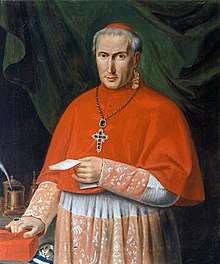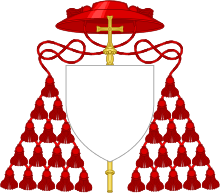Giacomo Giustiniani
Giacomo Giustiniani (1769–1843) was an Italian papal diplomat and Cardinal. Considered papabile in the Papal Conclave (1830–31), his election was vetoed by Ferdinand VII of Spain.[1]
Giacomo Giustiniani | |
|---|---|
| President of the Congregation of the Reverend Basilica of Saint Peter | |
 | |
| Church | Roman Catholic Church |
| Appointed | 1 July 1837 |
| Term ended | 24 February 1843 |
| Predecessor | Pietro Francesco Galleffi |
| Successor | Mario Mattei |
| Other posts |
|
| Orders | |
| Ordination | 21 December 1816 |
| Consecration | 20 April 1817 by Alessandro Mattei |
| Created cardinal | 2 October 1826 by Pope Leo XII |
| Rank | Cardinal-Priest (1827–39) Cardinal-Bishop (1839–43) |
| Personal details | |
| Birth name | Giacomo Giustiniani |
| Born | 29 December 1769 Rome, Papal States |
| Died | 24 February 1843 (aged 73) Rome, Papal States |
| Buried | Santa Maria sopra Minerva |
| Parents | Benedetto Giustiniani Cecilia Carlotta Mahoni |
| Previous post |
|
| Alma mater | La Sapienza University |
| Styles of Giacomo Giustiniani | |
|---|---|
 | |
| Reference style | His Eminence |
| Spoken style | Your Eminence |
| Informal style | Cardinal |
| See | Cardinal bishop of Albano |
He was the younger brother of Vincenzo Giustiniani, 6th Prince Giustiniani, de jure 6th Earl of Newburgh.[2]
His career in the priesthood was interrupted by the Napoleonic Wars, and he was ordained in 1816. In 1817 he was papal nuncio in Spain and became titular archbishop of Tyre. He became bishop of Imola in 1826.
He was created Cardinal by Pope Leo XII in 1826. He became bishop of Albano in 1839 and he became Camerlengo in 1837.
Notes
- Sede Vacante 1829, 1830
- proc, Parliament lords (1830-01-01). 4 papers relating to claims to the earldom of Newburgh.
This article is issued from Wikipedia. The text is licensed under Creative Commons - Attribution - Sharealike. Additional terms may apply for the media files.